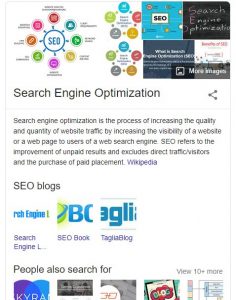
This year is already 2 months done, so how are your business sales and marketing goals going?
Most business owners – perhaps including you – are unaware of exactly what it takes to get their websites ranking well online, but the higher in search engine rankings your business ranks, the better the traffic and hopefully therefore leads your website will get…
“The best place to hide a dead body is on the second page of Google search results.” – old internet joke…
Google’s search engine algorithm has increasingly adapted to harsher text content requirements, catering to a fickle audience, and, most importantly, implementing new tools and technologies.
So in 2020, let’s see what you can do to tweak your SEO efforts today.
1. Focus on Your Core Business Talents
SEO efforts are often industry-specific. What works for a healthcare provider turns into a bad marketing strategy for a flower shop.
With the amount of information on the web growing exponentially daily, monthly, yearly – it’s important to focus on what you do best. Spreading yourself thin to catch a larger target audience may not be the answer.
Concentrate on what’s important for your industry and capitalize on it. This is true for the nature of your content, long-tail keywords, webpage indicators (loading speed, mobile version, etc.), linking, and much more. Niche down to reap search engine rankings rewards.
 2.Getting Into the Featured Snippet
2.Getting Into the Featured Snippet
The featured snippet gives you the “zero” position on the search engine results, thus offering your website endless conversion opportunities.
According to HubSpot’s research, getting into Google’s featured snippet could increase your click-through rate by over 100%.
While some marketing experts are skeptical about the snippet, numbers speak for themselves. If you get there, Google thinks you are a winner. Here is what you can start with:
-
- Adjust headers to feature the common queries related to your products/services.
- Adapt your content to appear easily readable on the snippet. Sections must be concise.
- Use SEMrush to find competitors’ featured snippets and find out which snippets you rank for.
- Take advantage of AnswerThePublic and QuestionDB to find out which questions your target audience wants to be answered (a big chunk of content in the featured snippets answers questions that start with “how to” and “how do you”).
- Use numbered and bullet lists to summarise your content.
- Again niche down, answer specific questions related to your industry.
3. Improving Your Content to Satisfy BERT
If SEO could be referred to as a hamburger, then content is the meat. Without constantly improving your content, it’s impossible to say on top of the race for the top spot. Google algorithms are becoming better and better in singling out worthy articles. It’s up to you to keep up with the requirements.
For example, RankBrain is a Google algorithm that determines a user’s intent during a search. With the right approach, it’s possible to adjust your content to appear more valuable to RankBrain. However, “tricking” its newest partner BERT is out of the question.
All you have left is improving the quality of your content to fulfill the intent your users are seeking.
The key takeaway here, just because your website is online it isn’t done – you need to review and refresh and update your content periodically. Optimise, expand on and improve it and you will get a rankings boost.
4. Investing in Visuals
Visual content is becoming more and more popular. According to Cisco’s forecast, by 2021, the global internet traffic from videos will make up 82% of all consumer internet traffic. That’s why keeping focus on videos is vital for your 2020 SEO campaign.
Visuals can be tricky since they need more work than textual content. Meanwhile, you can achieve a better effect by attaching text to some of your visuals. For example, the explanatory text should accompany infographics while videos could have a transcript.
Remember, even though the importance of alt text for visuals is tough to underestimate, it may not be sufficient without the accompanying text.
5. Working on Speed
The need for speed in 2020 is on the rise. Search engines are paying extremely close attention to how much you value your visitor’s time. So it’s up to you to check the entire website to ensure:
-
- Fast loading speed for each webpage – your visuals may be slowing the website down so adjust their size.
- Well-structured text – without headers, bullet points, and short paragraphs, your text isn’t skimmable, which makes it a time-waster.
About 47% of consumers expect the website to load in two seconds or less, and Google knows it. Take advantage of the PageInsights Tool to find out where you stand speed-wise.
6. Building Relevant Mentions
While you may have been focusing on brand awareness anyway, give it a little extra effort in 2020. Simple mentions of your brand and quotes from your articles could do just as good of a job improving your rankings as backlinks do.
Using such tools as mention.com can help you find and evaluate existing mentions as well as see what works for the competition.
Even though you can turn mentions into links, in 2020 it’s not as important as it used to be. Here are a few ways you can build relevant brand mentions:
-
- Guest blogging – find sites relevant to your niche that accepts guest posts. You can mention your brand in the author’s bio or inside the text (if allowed by guidelines).
- Reviews – by providing excellent service, you are encouraging reviews, which feature brand mentions. By the way, negative reviews work too.
- Influencers – with influencers in your niche mentioning your brand, you don’t just increase awareness, you help tweak SEO efforts.
7. Adjusting to Voice Search Optimisation
According to Statista, by 2023, the number of voice assistants in the world will surpass the number of humans. Optimising for voice search is on the agenda of thousands of marketers all over the world.
The structure of voice requests is different from typed questions. Voice search keywords are longer and conversational. For example, “dyeing hair blond” has turned into “Hey, Siri, how do I dye my hair blond at home?”
That’s why your entire content creation strategy may need some serious tweaking. You could start with:
-
- Optimising for rich answers
- Restructuring content to provide concise answers (FAQ sections could help with this one tremendously)
- Using conversational language
- Targeting long-tail keyword phrases
- Speeding up the website loading time
Staying on Top of Your SEO Game
By taking advantage of the above-mentioned strategies, you can stay on top of the SEO game…for a while. It’s vital to continue monitoring new trends, search engine requirements, and clients’ preferences to keep your marketing campaign alive.
Do you need help in implementing these strategies for search engine rankings success? Contact us at natiive today for an objective, independant review and audit of your website and then we can provide you with strategies (based on proven results) to get you dominating your industry.



